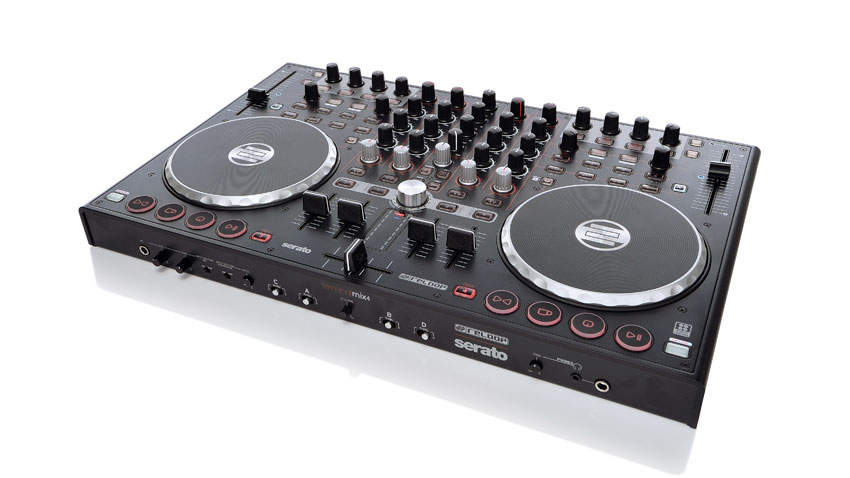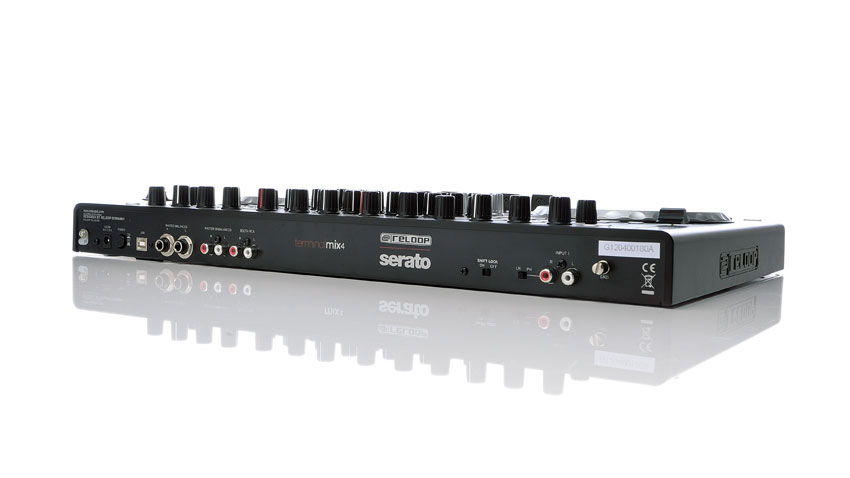MusicRadar Verdict
Solid design with great jogwheels, but, bafflingly, the software only supports two of the four channels.
Pros
- +
Solid design. Top-notch platters. Quality audio.
Cons
- -
Bundled software lets it down. Slightly cramped layout.
MusicRadar's got your back

Reloop Terminal Mix4

Reloop Terminal Mix4 (back)
The controller market has been steadily producing some contenders, hell bent on knocking traditional DJing hardware into submission. Novation's flyweight Twitch had some nifty jabs, including its Touchstrip interface and crowd-pleasing Slicer finishing move. The goliath Numark 4Trak, on the other hand, boasts weighted seven-inch turntables, but needs two people to help carry it into the ring.
After the poor finishing power of its Digital Jockey III, German company Reloop have finished licking their wounds and are betting the farm on their new four-channel digital Serato controller, Terminal Mix 4. In a market fuelled on hype, how does it fare?
"Fresh out the box its no-nonsense design, weight and size set it up as a sturdy customer"
Fresh out the box its no-nonsense design, weight and size set it up as a sturdy customer. A quick fiddle with the knobs, buttons and jogwheels confirms first impressions. Its layout makes it hard to pick out of a crowd of other controllers like the Vestax VCI-400 or the Numark NS6. Reloop have seemingly plumped for a design that everyone can relate to and fathom at first glance.
It's either USB or mains powered. We went straight into the laptop and it was perfect. At your fingertips you have four channels, with dedicated faders, three-band EQ knobs and a tasty little filter that takes you from a quality low to high-pass in a satisfying twist.
You also get an FX section for each deck with the usual suspects in tow: chop, filter, echo and so on. Then we have hot cue buttons that, although small, are responsive and punchy. We also get a nifty bank of sample buttons right above the jogwheels that come through the master, so you can happily stab in that obligatory air horn or those DJ shouts all over your mix.
Bang in the middle of the controller is a brushed metal library jogwheel. Again, it's solid as a rock and makes cueing up and selecting beats a doddle. The looping features are as you'd expect with Serato, but can only be adjusted from one to eight beats in length.
Pitch perfect
Pitch control is handled by full-sized faders that glide effortlessly and handle stretching the pitch out without losing quality in the audio, which is peerless across the board on the TM4. The crossfader is also superb. Its 2mm cut limit is more than enough for scratching, so getting your Twiddles and Crabs down isn't a problem. The cut adjustment is within easy reach as well, so nipping between a long transition and stabby mixing style is simple.
Overall the FX are easily controllable, a pinch to sync, and fun to use. And the layout, although a tad pedestrian in appearance and a little cramped, houses everything where you'd expect it to be.
"It's the state of the software that lowers the TM4's guard and exposes it to some stinging body blows"
After a strong showing in the first round, it's the state of the out-the-box software that lowers the TM4's guard and exposes it to some stinging body blows. Reloop is proud to announce that the TM4 has been designed for Serato, and struts the logo around its packaging and promotional material. Yet, it's packaged with Serato Intro, a perfectly functional but toothless younger brother to Itch. And an amateurish Reloop edition of Virtual DJ.
After diving in and trying some of the performance buttons we got a little confused. Why are some buttons offline? Why did a little image of scissors light up but do nothing? Why is the Loop Move Knob redundant? And, crucially, where are our other two decks? To get what you've paid for, you have to persist with the limp VDJ with noticeably sluggish latency (or pay for a pro version). It leaves you feeling a little sucker punched.
Hands off decks we would have loved to have had a fiddle with four-deck mixing in a version of Serato for layering up a capellas, or maybe having a dedicated scratch deck to cut to on the fly. Here's hoping future updates will include pro versions of the VDJ software, or Itch integration so Serato heads can gets their mitts on those other two decks.
It is worth mentioning that Reloop also does a cheaper two-channel version in the guise of the Terminal Mix 2. And via the Reloop website you can download different MIDI mapping files for other DJ software. Out the box it comes with two Traktor maps. But, like the others, if you want to use the software you have to buy it. It's Serato it claims to be built for, and it's users of that who will be the first to size up the TM4 - and ultimately be disappointed by the loss of decks and features, at this stage.
It's all about the upgrade path. We'd really like to see a fully Scratch Live ready version of this, but if anything comes out with that on the box, it's probably going to say Rane and not Reloop on the side. The TM4 had the promise of being the NI Kontrol S4 for the dedicated Serato head. That beauty was built by Traktor for Traktor, and the degree of integration is beyond compare. The TM4 is a truly professional piece of kit that can slug it out with the best of them as hardware, but it needs the software to really pack a punch.
“A synthesizer that is both easy to use and fun to play whilst maintaining a decent degree of programming depth and flexibility”: PWM Mantis review
“I feel like that song had everything we needed to come back with”: Bring Me The Horizon’s Lee Malia on Shadow Moses, its riff and the secrets behind its tone, and why it was the right anthem at the right time
“I said, ‘Are we sure we can write a song about death?’”: The story of Mike + The Mechanics' classic No.1 The Living Years









